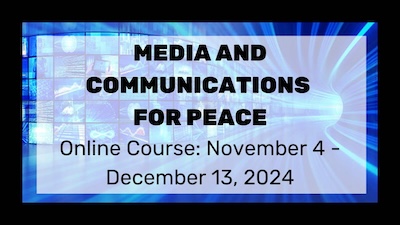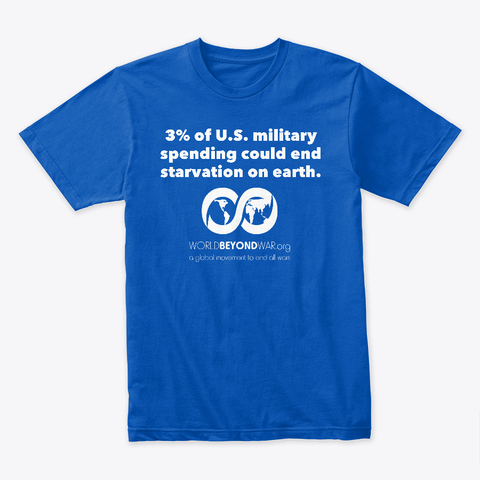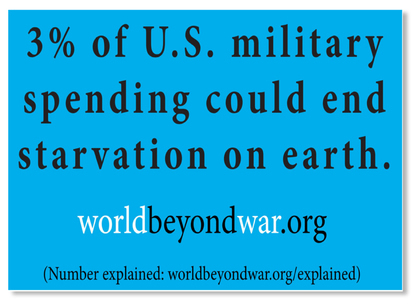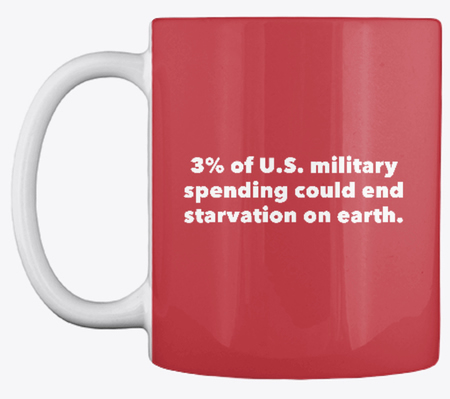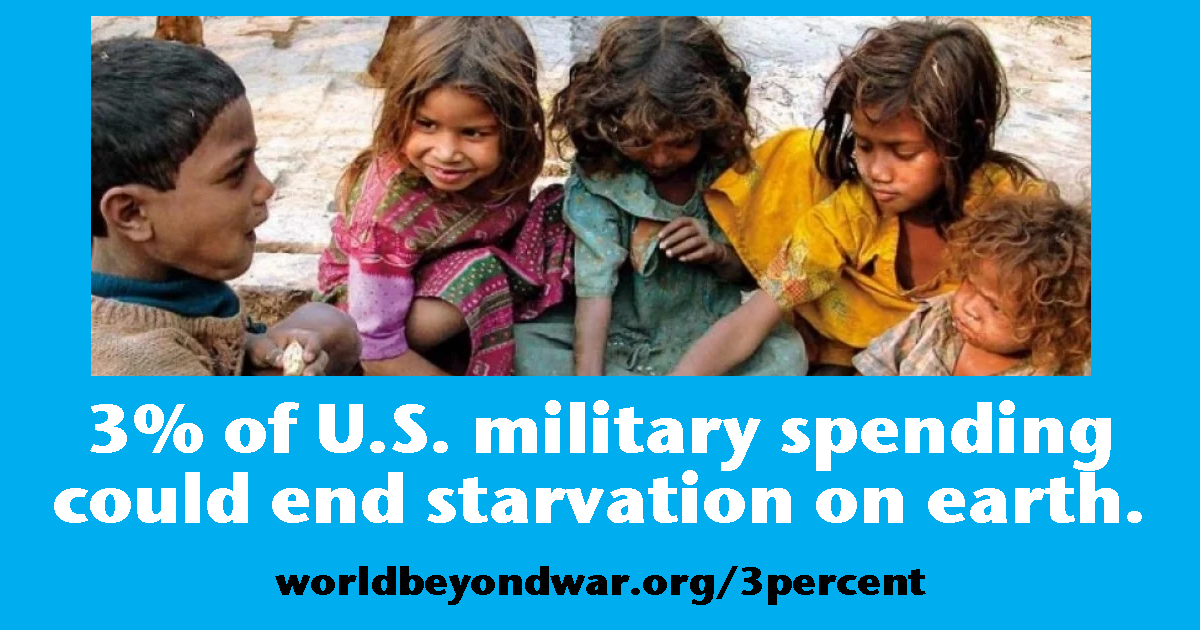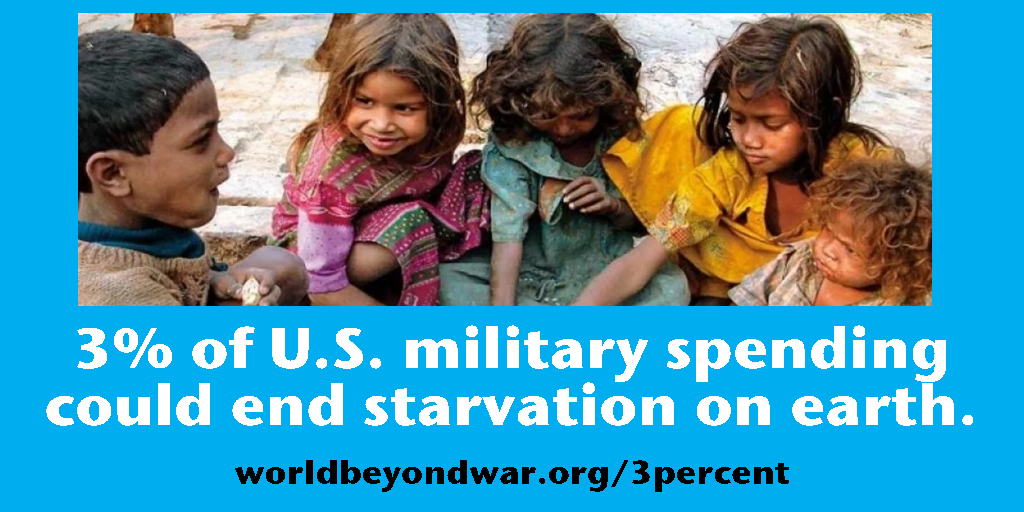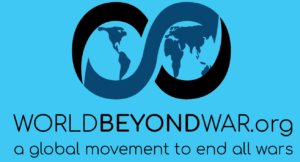Here’s a proposal that could end starvation around the globe. Never again need a human being lack the food to live. Never again need a single child or adult suffer the horrors of starvation. Hunger as a danger to anyone can be made a thing of the past. All that is required, apart from basic skills in distributing resources, is 3 percent of the military budget of the United States, or 1.5 percent of all the military budgets in the world.
In recent years, the U.S. military budget has been increased dramatically. This plan would scale it back to 97 percent of its current level, a difference far smaller than the amount that goes unaccounted for each year. U.S. military spending would remain over twice that of the most common enemies designated by the U.S. government — China, Russia, and Iran — combined.
But the change to the world would be tremendous if starvation were eliminated. The gratitude felt toward those who had done it would be powerful. Imagine what the world would think of the United States, if it were known as the country that ended world starvation. Imagine more friends worldwide, more respect and admiration, fewer enemies. The benefits to communities assisted would be transformational. The human lives rescued from misery and incapacitation would constitute an enormous gift to the world.
Here’s how 3 percent of U.S. military spending could do it. In 2008, the United Nations said that $30 billion per year could end hunger on earth, as reported in the New York Times, Los Angeles Times, and many other outlets. The Food and Agriculture Organization of the United Nations (UN FAO) tells us that number is still up to date.
As of 2019, the annual Pentagon base budget, plus war budget, plus nuclear weapons in the Department of Energy, plus military spending by the Department of Homeland Security, plus interest on deficit military spending, and other military spending totaled well over $1 trillion, in fact $1.25 trillion. Three percent of a trillion is 30 billion.
Global military spending is $1.8 trillion, as calculated by the Stockholm International Peace Research Institute, which only includes $649 billion of U.S. military spending as of 2018, making the actual global total well over $2 trillion. One-and-a-half percent of 2 trillion is 30 billion. Every nation on earth that has a military can be asked to move its share to alleviate hunger.
The Math
3% x $1 trillion = $30 billion
1.5% x $2 trillion = $30 billion
What We Propose
Our proposal is that the U.S. Congress and a future U.S. administration, dedicated to the goal of eradicating hunger, begin by ending sanctions on other nations which increase starvation, and by enacting an annual reduction in military spending of at least $30 billion. A number of think tanks have proposed various ways in which military spending could be reduced by that amount or more. These savings should be specifically diverted to programs designed to reduce hunger worldwide, and the direct tradeoffs between military cuts and hunger eradication should be presented explicitly to U.S. taxpayers and to the world.
How these funds would be spent requires detailed analysis, and would likely change each year as specific food needs arise. First, the United States could increase its international assistance, both for immediate humanitarian relief and longer term agricultural development, to a per capita level comparable to other major donors, such as the UK, Germany, and a number of Scandinavian countries. In the immediate term, the United States should increase its contributions to the UN World Food Program’s appeals for funds needed to respond to humanitarian crises worldwide (many of which are due to conflicts that are fueled by U.S. weapons sales and/or by the actions of the U.S. military).
Part of this funding also should be dedicated to longer term, sustainable improvement of agriculture and food market systems in vulnerable countries, through the Food and Agriculture Organization of the United Nations, as well as various research institutes and foundations specializing in these areas. Although the World Bank and other international financial institutions have a mixed record in terms of benefiting the neediest, consideration should be given to increasing U.S. contributions specifically tied to assisting the agriculture ministries of certain select countries, as a means of improving long term food security in these countries.
The only strings attached to these donations would be that the use of the funds needs to be completely transparent, with every expenditure publicly recorded, and that the funds be distributed purely on the basis of need, influenced in no way by politically driven agendas.
The steps outlined above could be undertaken with minimal new legislative authorities or reorganization of the U.S. Government. A future U.S. administration could put forward to Congress budget requests, and regardless Congress could enact budgets, that dramatically increase assistance programs administered by the State Department (not including those related to military assistance). This should also involve a change in assistance priorities, to focus on the neediest countries and turn away from politically motivated programs. Initiatives already in existence, such as the Feed the Future program, created during the Obama Administration but still continuing today, should be provided with increased funding. What is required is sufficient will to act.
FAQ
Doesn’t the UN FAO say that $265 billion is needed to end hunger, not $30 billion?
No, it does not. In a 2015 report, the UN FAO estimated that $265 billion per year for 15 years would be necessary to permanently eliminate extreme poverty — a much broader project than just preventing starvation one year at a time. The FAO’s spokesperson explained in an email to World BEYOND War: “It would be incorrect to compare the two figures [$30 billion a year to end hunger vs. $265 billion over 15 years] as the 265 billion has been calculated taking into consideration a number of initiatives including social protection cash transfers aimed at extracting people from extreme poverty and not just hunger.”
The U.S. government already spends $42 billion per year on aid. Why should it spend another $30 billion?
As a percentage of gross national income or per capita, the U.S. gives much less aid than other countries do. Plus, 40 percent of current U.S. “aid” is not actually aid in any ordinary sense; it’s deadly weapons (or money with which to buy deadly weapons from U.S. companies). In addition, U.S. aid is not targeted based purely on need but based largely on military interests. The biggest recipients are Afghanistan, Israel, Egypt, and Iraq, places the United States deems most in need of weapons, not places an independent institution deems most in need of food or other aid.
Individuals in the U.S. already give private charitable donations at high rates. Why do we need the U.S. government to provide aid?
Because children are starving to death in a world awash in wealth. There is no evidence that private charity decreases when public charity increases, but there is lots of evidence that private charity is not all it’s cracked up to be. Most U.S. charity goes to religious and educational institutions within the United States, and only a third goes to the poor. Only a small fraction goes abroad, only 5% to assist the poor abroad, only a fraction of that toward ending starvation, and much of that lost to overhead. The tax deduction for charitable giving in the United States appears to enrich the rich. Some like to count “remittances,” that is money sent home by migrants living and working in the United States, or the investment of any U.S. money abroad for any purpose, as foreign aid. But there is simply no reason that private charity, no matter what you believe it to consist of, could not remain the same or increase if U.S. public aid were brought closer to the level of international norms.
Isn’t world starvation and malnourishment decreasing anyway?
No. Increases in conflicts around the world and climate-related factors have contributed to an increase of 40 million people malnourished in recent years. Although there has been slow progress in reducing malnourishment over the last 30 years, the trends are not encouraging and approximately 9 million people die each year from starvation.
What is the plan to do this?
- Educate the public
- Build a movement
- Enlist support from key Congressional offices
- Introduce supporting resolutions in the United Nations, U.S. Congress, governing bodies of other countries, U.S. state legislatures, city councils, and civic, charitable, and faith-based organizations
What You Can Do
Endorse the 3 Percent Plan to End Starvation on behalf of your organization.
Help us put up billboards in key locations around the United States and the globe by contributing here. Can’t afford a billboard? Use business cards: Docx, PDF.
Join or start a chapter of World BEYOND War in your area that can hold educational events, lobby legislators, and spread the word.
Support World BEYOND War with a donation here.
Contact World BEYOND War to get involved in this campaign.
Write an op-ed or a letter to the editor using the information on this page, your own words, and these tips.
Print this flyer in black and white on colored paper: PDF, Docx. Or print this flyer.
Ask your local government to pass this resolution.
If you are from the United States, send this email to your Representative and Senators.
Wear the message on your shirt:
Share on Facebook and Twitter.
Use these graphics on social media:
Facebook:
Twitter:

